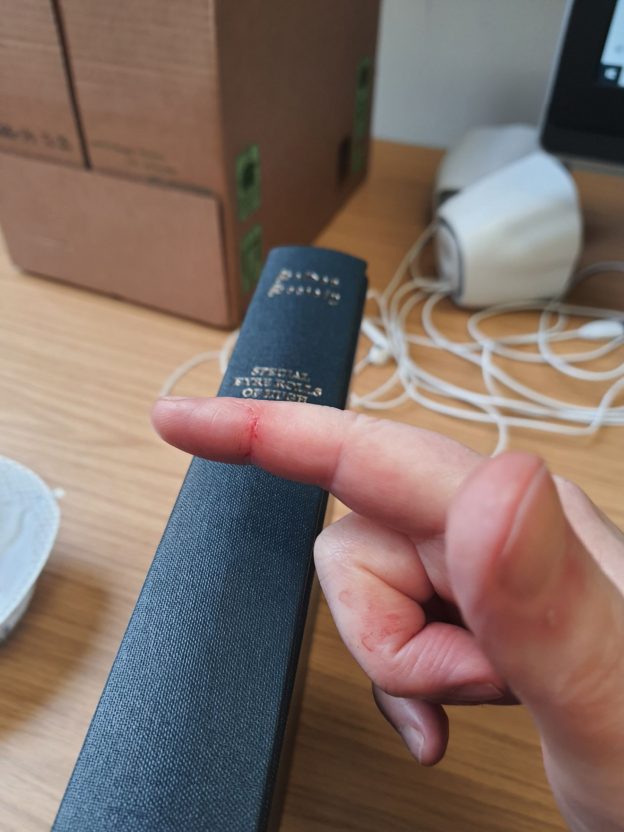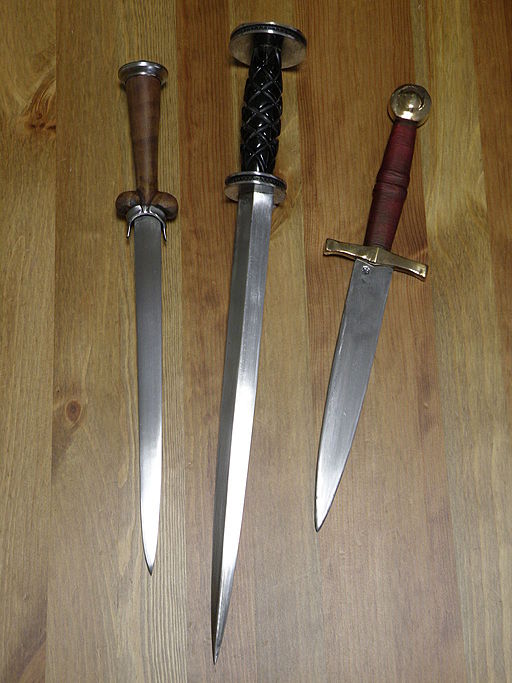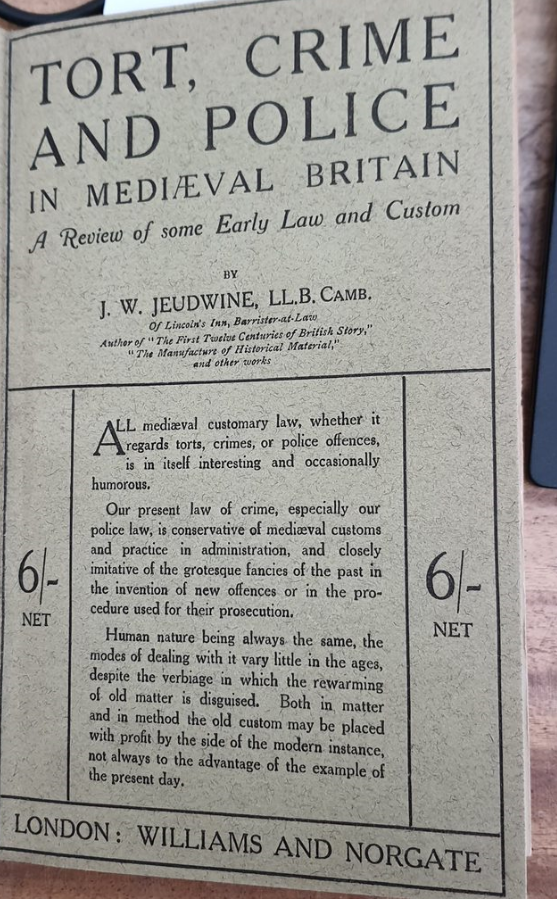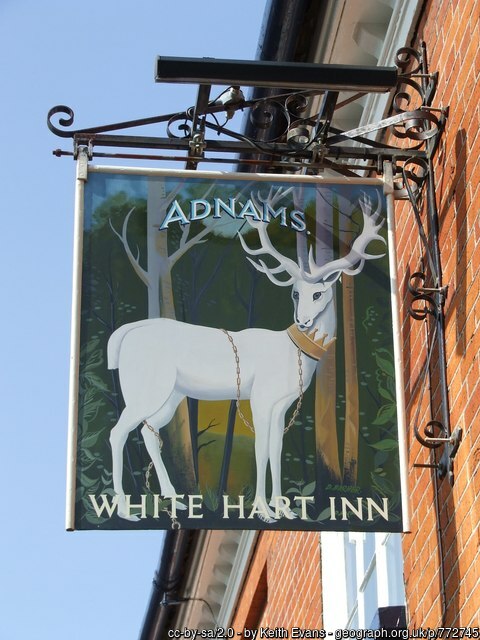Rather later than many people, I have finally had a chance to have a good look at the latest delivery from the Selden Society – A.H. Hershey (ed.), Special Eyre Rolls of Hugh Bigod 1258-60 Selden Soc vols 131 and 133. These have been waiting for me in my pigeon hole at Bristol for a while, but I have only just been able to get into the Wills Memorial Building, after returning from my travels, to get my paws on them. As you will see from the image above, in my clumsy eagerness, I managed to injure myself during the ‘unboxing’ process. I managed to leave some blood spatters on one of the books, so my DNA is now on them, I suppose. Hard core legal historian or what?
The volumes are editions (and translations) of some eyre records (JUST 1/1187, JUST 1/1188 JUST 1/1189, National Archives fans) from sessions by Bigod, the justiciar, just after the big King-barons upheavals of Henry III’s reign, and they are well worth a look for anyone interested in this period, or in legal history generally. From the point of view of my research, there are some interesting entries on non-fatal injury, and on pregnancy/foetuses, and, as ever, I remain interested in seeing the extent to which women are dealt with in the commentary, index etc.
So, a few points …
- There is some interesting stuff here about the use of querela procedure – complaints without the usual formal requirements. These are always really interesting, in that they feel like a bit of a window on to what people actually want the law to do. Obviously not unmediated, but less mediated. I have noted in the past that they are particularly useful for women, whose routes to justice were generally rather more constrained (e.g. I have mentioned this in relation to sexual abuse of various sorts, see here). The introduction to SS 131, at xxvii makes a good point about the limits to the freedom which was allowed when bringing this sort of action – clearly not possible wholly to contradict common law rules by going down the querela route. Still, they can be pretty informative.
- The introduction does also make special mention of women’s use of this process – see xlv – which is good to see. Dower/freebench features pretty heavily, and I found particularly interesting the section at xlvi relating to Cecilia widow of William son of Roger of Hatfield and her freebench claim. Her case – no. 24 – engages with a manorial custom relating to freebench in Hatfield. The ‘upside’ was that it was relatively generous in extent – a qualifying widow became ‘life tenant’ of all of the lands her husband had held in the manor. The ‘downside’ was that the qualifying test was pretty strict. Not only did the widow have to remain chaste (which Cecilia claimed she had) but there had to be a surviving legitimate child with the dead husband. This is where Cecilia fell down: her son had died. Conceptually, I suppose I ‘get’ the rule: freebench was something of a ‘dower meets child maintenance’ concept here, it would seem. Still, though, it would presumably mean compounding the tragedy of a woman who had lost both husband and child. Interesting to see that in this case, she seems to have cut a deal with the other claimant to the land, and was not left with nothing. Manorial equity?
- There is some very interesting material relevant to pregnancy and foetuses. Intro p. xlvii and entry no 141 relate to a Bucks complaint of Sibil, wife of Roger Grey, knight, that she had been assaulted, in an attack on her husband, leading her to miscarry the child she was carrying, and to be unwell enough to have to stay in her bed for some time afterwards. There is a lot which is interesting about this case. First of all, the blows she suffered were alleged to have happened while she was trying to protect Roger, the main target of the beating – interesting from a gender roles POV, even if the editor is not convinced it is realistic in this particular case. Secondly, the miscarriage was alleged to have happened not at once, but three weeks after the attack. Very interesting in terms of causation, which is one of my current concerns. Apparently that was thought to be a plausible claim, despite what one imagines would have been the relative frequency of pregnancies ending badly. As Hershey notes, this is all quite interesting in terms of its relationship to the sorts of cases women were allowed to bring by appeal, but there is also more to unpack, I think, in terms of what it means for our understanding of contemporary views on pregnancy and the foetus. I am wondering what to make of the ‘confined to bed’ claim – was there a doubt that loss of the foetus in and of itself was the sort of harm which ‘counted’, and it felt safer to emphasise the harm to the woman?
- Also fascinating (and horrible) on pregnancy, foetuses etc is no. 126 at p. 120 ff: amongst the accusations against William of Rushton of Oxfordshire (and some henchmen) is the accusation of wrongful execution of a woman. Sarah of Islip was said to have been hanged for theft, without proper judgment, when she had a good explanation for her possession of the allegedly stolen goods (cloth) and when she was very pregnant. All sorts of interest here. Hershey concentrates in the introduction on the wrongful execution point, but the entry itself has some really useful passages describing late pregnancy, and, incredibly chillingly, on the idea that a woman facing execution might be resigned to her own death, but plead for those threatening her to cut her open (presumably after death?) and save her child. What an appalling scene that conjures up – and what a priceless insight into more than one issue relating to law, medicine and the (plausibly set forth) emotions and attitudes of a medieval woman.
- There is also some useful stuff on the mayhem/non-fatal injury front, including a case of partial blinding with, shall we say, an interesting alternative portrayal of causation (woman alleges she is thumped, causing her to lose sight in one eye; jury alternative explanation is that fumes associated with her brewing blinded her in one eye, and only one eye …am I wrong to be unconvinced at their good faith?) – p. 297 no 349.
(There are also lots of general land cases, procedure etc, for those who like that sort of thing, preferring their legal history a little less bloody …)
14/12/2021
GS









